(How to Create Guardian Angels.)
Excerpted from Christ in the Under-World by Lilian M. Heath, 1907.
In one of the larger cities of the Under-World is a great university, where the substantial brick and stone buildings — nearly twenty of them — are equipped with the best twentieth century facilities for study. […] the building which seemed to attract me most, at this particular time, was the chemical laboratory. […] After a short rest I arose and walked up to the entrance.
Nobody disputed my right to enter, and I made my way into a large room where several students were grouped around a table, waiting for something or someone.
In this light I saw a wonderful sight. As I looked at one of the students, there gradually appeared, close around him from head to foot, a colored light or enveloping frame, following exactly the lines of the student’s form, but extending outward for several inches.
“There he comes, now,” said one of them, as a firm, rapid step approached. In a moment the door opened and a man with iron gray hair and keen eyes to match came in. He was evidently a professor of chemistry, or of some other science, for he carried in his hands several small tubes and a delicate-looking little instrument, I supposed for testing. By this time the rest of the class had joined the early arrivals, and I was courteously welcomed as I said that I should greatly enjoy watching some of their experiments.
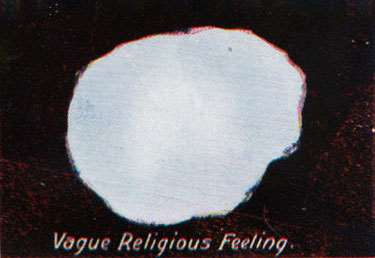 The professor, seating himself at the table, took one of the tubes, and after directing that the window shades be drawn down — an order at which I wondered, as it left the scene of their experiments almost in darkness — he placed a few drops of a colorless liquid into the tube and added to it a little white powder.
The professor, seating himself at the table, took one of the tubes, and after directing that the window shades be drawn down — an order at which I wondered, as it left the scene of their experiments almost in darkness — he placed a few drops of a colorless liquid into the tube and added to it a little white powder.
Instantly there arose a thin, curling vapor which as it left the tube settled itself gradually over the room till it spread itself into invisibility again.
Strange to say, the effect of the vapor was the opposite of what might have been expected — that is, instead of thickening the air it seemed to clear it, and make it luminous with a pure, soft light.
In this light I saw a wonderful sight. As I looked at one of the students, there gradually appeared, close around him from head to foot, a colored light or enveloping frame, following exactly the lines of the student’s form, but extending outward for several inches. There were various colors, yellow and blue and green, but the yellow seemed to predominate.
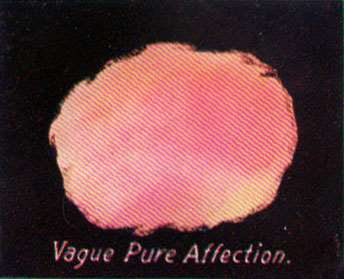 Then I looked at the other students, each in turn. Every one was wrapped in the same flame-like mantle, the colors differing somewhat with the different individuals, one illumined with mingled rose-pink and pale green, another with light blue and orange; even the professor was surrounded with a primrose yellow glow.
Then I looked at the other students, each in turn. Every one was wrapped in the same flame-like mantle, the colors differing somewhat with the different individuals, one illumined with mingled rose-pink and pale green, another with light blue and orange; even the professor was surrounded with a primrose yellow glow.
Suddenly the professor took up another tube which had been closed at both ends. After a moment’s delay he succeeded in opening it. Another vapor for an instant obscured the view. Then, as it cleared, we could see not only the bordering mass of color hovering so closely around each person, but in that color were thousands of small, curiously shaped objects darting about with lightning rapidity. There were circular disks, triangles, crescents, stars and flowers, all more or less clearly defined, but most common of all were two shapes, one like the palm of a tiny hand with hook-like fingers, another simpler one much like a short, pointed pencil.
Looking down at myself, I with difficulty suppressed a startled exclamation; for close around me, so close I could watch them plainly, darted up and down, back and forth, a colony of millions of orange-yellow, wavy objects like small but very lively snakes!
Sincerely hoping that these wriggling visitors were harmless, I recovered my breath as best I could, and began listening to the professor’s lecture to the class. His subject proved to be psychology instead of chemistry.
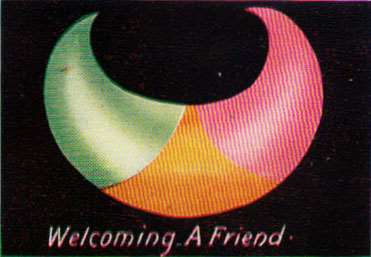 “Each individual,” said he, “travels through space inclosed within a cage or, as it is called, an aura, of his own building, surrounded by a mass of forms created by his habitual thoughts. Through this medium he looks out upon the world and naturally sees everything tinged with its predominant colors; and all rates of vibration which reach him from without are more or less modified by its rate. Thus until a man learns complete control of thought and feeling he sees nothing as it really is, since all his observations must be made through this medium, which distorts and colors everything like imperfectly made glass. Vibrations of light, of sound and of all else are thus affected by reaching the person through this enveloping aura.”
“Each individual,” said he, “travels through space inclosed within a cage or, as it is called, an aura, of his own building, surrounded by a mass of forms created by his habitual thoughts. Through this medium he looks out upon the world and naturally sees everything tinged with its predominant colors; and all rates of vibration which reach him from without are more or less modified by its rate. Thus until a man learns complete control of thought and feeling he sees nothing as it really is, since all his observations must be made through this medium, which distorts and colors everything like imperfectly made glass. Vibrations of light, of sound and of all else are thus affected by reaching the person through this enveloping aura.”
“How does a man’s thought affect his aura, Professor?” asked one of the students, for they were encouraged to ask questions.
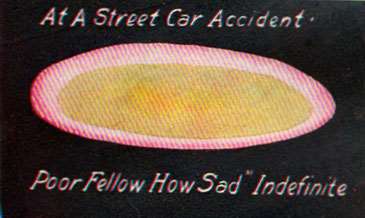 “Each definite thought,” he explained, “produces a double effect — a radiating vibration and a floating form. The thought itself appears as a vibration, and this may be simple or complex. If the thought itself is absolutely simple, that is, not mixed with any other thought, there is only one rate of vibration and only one type of mental matter will be strongly affected. When a sudden wave of some emotion sweeps over a man, for example, his aura is thrown into violent agitation and its original colors are for the time almost obscured by the flush of rose or of blue or some other color which corresponds with the rate of vibration of that particular emotion. This change is only temporary; it passes off in a few seconds, and the aura of surrounding color rapidly resumes its usual condition. Yet every such rush of feeling has one permanent effect; it always adds a little of its own hue to the normal coloring of the surrounding aura, so that every time a man yields to a certain emotion it becomes easier for him to yield to it again, because his aura is getting into the habit of vibrating at that especial rate.
“Each definite thought,” he explained, “produces a double effect — a radiating vibration and a floating form. The thought itself appears as a vibration, and this may be simple or complex. If the thought itself is absolutely simple, that is, not mixed with any other thought, there is only one rate of vibration and only one type of mental matter will be strongly affected. When a sudden wave of some emotion sweeps over a man, for example, his aura is thrown into violent agitation and its original colors are for the time almost obscured by the flush of rose or of blue or some other color which corresponds with the rate of vibration of that particular emotion. This change is only temporary; it passes off in a few seconds, and the aura of surrounding color rapidly resumes its usual condition. Yet every such rush of feeling has one permanent effect; it always adds a little of its own hue to the normal coloring of the surrounding aura, so that every time a man yields to a certain emotion it becomes easier for him to yield to it again, because his aura is getting into the habit of vibrating at that especial rate.
“The majority of human thoughts, however, are by no means simple. This means that at least two separate vibrations appear in the aura — frequently more than two. The radiating vibration is a complex one, and the resulting thought forms will show several colors instead of only one. These radiating vibrations, like all others in nature, become less powerful in proportion to the distance from their source, though, like vibrations of light, they travel miles in an instant, and tend to reproduce themselves wherever opportunity is offered them.”
“Does this explain the action of one mind upon another?”
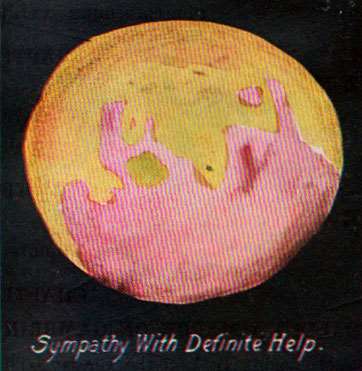 “Yes. Whenever these thought-waves strike upon another mental body they tend to produce in it their own rate of motion. That is, they tend to produce in the mind of the receiver thoughts of the same type as that which had previously arisen in the mind of the thinker who sent them forth. The distance such thought-waves travel and the force and persistency with which they affect the minds that they reach depend upon the strength and clearness of the original thought. But clearness and definiteness are of even greater importance than strength. A man thinking keenly upon some high subject pours out from himself on all sides vibrations which tend to stir up thought of a similar high level in others. They naturally act with especial vigor upon those minds already habituated to vibrations of similar character; yet they have some effect on every mind that they reach, so that their tendency is to awaken the power of higher thought in those to whom it has not yet become a custom.”
“Yes. Whenever these thought-waves strike upon another mental body they tend to produce in it their own rate of motion. That is, they tend to produce in the mind of the receiver thoughts of the same type as that which had previously arisen in the mind of the thinker who sent them forth. The distance such thought-waves travel and the force and persistency with which they affect the minds that they reach depend upon the strength and clearness of the original thought. But clearness and definiteness are of even greater importance than strength. A man thinking keenly upon some high subject pours out from himself on all sides vibrations which tend to stir up thought of a similar high level in others. They naturally act with especial vigor upon those minds already habituated to vibrations of similar character; yet they have some effect on every mind that they reach, so that their tendency is to awaken the power of higher thought in those to whom it has not yet become a custom.”
“Please tell us about the thought-forms,” said a. student, as the professor paused, while note-books and pencils were busily catching up with the points of the lecture.
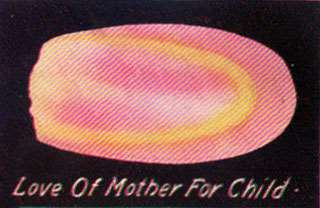 “Yes, now as to the second effect of thought, the creations of a definite form. Every thought or impulse sent forth from the mind becomes for the time a kind of living creature, the thought-force being the soul and the vivified matter the body. The chemicals we have been using so cleared the atmosphere that we can see these bodies which have thus taken form in the aura of each of us. Before this process of visible thought-formation was definitely known, some novelists were dimly aware if not of the laws governing it, at least of curious proofs that thoughts have life. Thackeray, for instance, testified that his characters when once created often developed a will of their own and insisted on carrying the plot of the story along lines quite different from those originally intended by the author. Each thought draws around it the matter which is appropriate for its expression, and sets that matter into vibration in harmony with its own. It is not unlike a Leydon jar, the coating of living essence corresponding to the jar, and the thought-force to the charge of electricity within.”
“Yes, now as to the second effect of thought, the creations of a definite form. Every thought or impulse sent forth from the mind becomes for the time a kind of living creature, the thought-force being the soul and the vivified matter the body. The chemicals we have been using so cleared the atmosphere that we can see these bodies which have thus taken form in the aura of each of us. Before this process of visible thought-formation was definitely known, some novelists were dimly aware if not of the laws governing it, at least of curious proofs that thoughts have life. Thackeray, for instance, testified that his characters when once created often developed a will of their own and insisted on carrying the plot of the story along lines quite different from those originally intended by the author. Each thought draws around it the matter which is appropriate for its expression, and sets that matter into vibration in harmony with its own. It is not unlike a Leydon jar, the coating of living essence corresponding to the jar, and the thought-force to the charge of electricity within.”
“What determines the color of these forms?”
 “Quality of thought determines color. Nature of thought determines form; and definiteness of thought determines clearness of outline. Let me explain this color law more fully. Black means hatred and malice. Red indicates anger; clear brown shows avarice; hard, dull brown-gray is a sign of selfishness; deep, heavy gray signifies depression; green seems always to denote adaptability, in the deeper tones deceit, while as the color becomes purer it means rather the wish to be all things to all men, and in its still more delicate and luminous aspect it shows the divine power of sympathy. Affection expresses itself in all shades of crimson and rose; a full, clear carmine means a strong, healthy affection of normal type, while pure pale rose marks that absolutely unselfish love which is the outpouring of high natures. It passes from the dull crimson of animal love to the most exquisite tints of delicate rose, like the early flushes of dawn, as the love becomes purified from all selfish elements and flows out in wider and wider circles of generous impersonal tenderness and compassion to all who are in need. With a touch of the blue of devotion in it this may express a strong realization of the universal brotherhood of humanity.”
“Quality of thought determines color. Nature of thought determines form; and definiteness of thought determines clearness of outline. Let me explain this color law more fully. Black means hatred and malice. Red indicates anger; clear brown shows avarice; hard, dull brown-gray is a sign of selfishness; deep, heavy gray signifies depression; green seems always to denote adaptability, in the deeper tones deceit, while as the color becomes purer it means rather the wish to be all things to all men, and in its still more delicate and luminous aspect it shows the divine power of sympathy. Affection expresses itself in all shades of crimson and rose; a full, clear carmine means a strong, healthy affection of normal type, while pure pale rose marks that absolutely unselfish love which is the outpouring of high natures. It passes from the dull crimson of animal love to the most exquisite tints of delicate rose, like the early flushes of dawn, as the love becomes purified from all selfish elements and flows out in wider and wider circles of generous impersonal tenderness and compassion to all who are in need. With a touch of the blue of devotion in it this may express a strong realization of the universal brotherhood of humanity.”
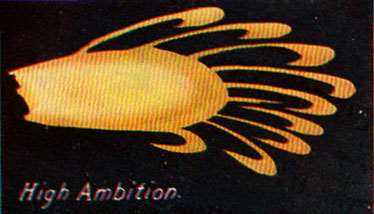 I glanced once more at my own aura. Was there an occasional streak of these happy colors in it, or was there not? Yes, there was a bit of clear blue; and there another; and just below it a touch of delicate rose color. But how little! I determined that hereafter there should be more!
I glanced once more at my own aura. Was there an occasional streak of these happy colors in it, or was there not? Yes, there was a bit of clear blue; and there another; and just below it a touch of delicate rose color. But how little! I determined that hereafter there should be more!
“Deep orange,” went on the professor, “indicates pride or ambition, and the various shades of yellow denote intellect or intellectual gratification.” (This, then, I saw, was the reason that yellow so largely predominated in the aura of each of the students present.) “Pale luminous primrose yellow being a sign of the highest and most unselfish use of intellectual power, the pure reason devoted to spiritual ends.”
Here I wondered if the professor had examined his own aura, but he went on, apparently quite unconscious that the description just given applied to himself.
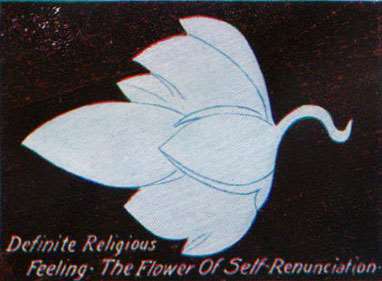 “The different shades of blue all indicate religious feeling, and range through all hues from the rich, deep, clear color of heartfelt adoration to the beautiful pale azure of that highest form which implies self-renunciation and union with the divine; the devotional thought of an unselfish heart is most lovely in color, like the deep blue of a summer sky. Through such masses of blue will often shine out golden stars of great brilliancy, darting upwards like a shower of sparks. A mixture of affection and devotion is manifested by a tint of violet, and the more delicate shades of this invariably show the capacity of absorbing and responding to a high and beautiful ideal.”
“The different shades of blue all indicate religious feeling, and range through all hues from the rich, deep, clear color of heartfelt adoration to the beautiful pale azure of that highest form which implies self-renunciation and union with the divine; the devotional thought of an unselfish heart is most lovely in color, like the deep blue of a summer sky. Through such masses of blue will often shine out golden stars of great brilliancy, darting upwards like a shower of sparks. A mixture of affection and devotion is manifested by a tint of violet, and the more delicate shades of this invariably show the capacity of absorbing and responding to a high and beautiful ideal.”
“Then even the shades, as well as the colors, are significant,” observed one student. “Are we to understand that the deeper the feeling the deeper the color, as a rule?”
“The brilliancy and depth of the colors are usually a measure of the strength and activity of the feeling. If a thought be purely intellectual and impersonal, if the thinker is attempting to solve a problem in geometry, the thought form and the wave of vibration making up the aura will be of a mental nature and the color will not be as luminous. If, however, the thought be of a spiritual nature, if it be tinged with love and aspiration or deep, unselfish feeling, it will rise upward from the mental plane and borrow much of the splendor and glory of the spiritual realm. In such a case its influence is exceedingly powerful, and every such thought is a mighty force for good which produces a decided effect upon all within reach, if they contain any quality at all capable of response.”
“Does it follow, then,” asked a student whose aura showed a tendency to sympathy, “that if thoughts are directed to individuals, those thoughts can definitely help or injure the one to whom they are sent?”
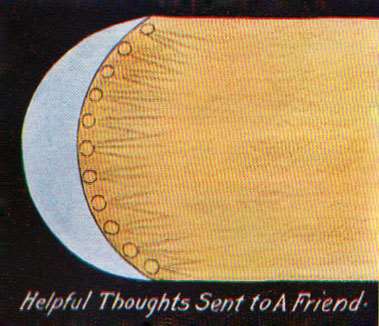 “In cases in which thoughts are projected at individuals,” was the reply, “those thoughts, if they are directly to fulfill their mission, must find in the aura of the object to whom they are sent material capable of responding sympathetically to their vibrations. Any combination of matter can only vibrate within certain definite limits, and if the thought form be outside all the limits within which the aura is capable of vibrating, it cannot affect that aura at all. It consequently rebounds from it, and that with a force proportionate to that with which it was impelled upon it, exactly like a ball or other elastic body. This is why it is said that a pure heart and mind are the best protectors against any malicious attacks, for such a pure heart and mind will construct an aura of fine and subtle materials, and these bodies cannot respond to vibrations that demand coarse and dense matter. A nature free from malice or evil tendencies is therefore its own best defense. If an evil thought strikes such a body it can only rebound from it, and it is flung back with all its own energy. It then flies backward along the magnetic line of least resistance, that which it has just traversed, and strikes the one who sent it forth; and he, having matter in his aura similar to that of the thought form he sent out, is thrown into responsive vibrations and suffers the destructive effects he had intended to cause another.”
“In cases in which thoughts are projected at individuals,” was the reply, “those thoughts, if they are directly to fulfill their mission, must find in the aura of the object to whom they are sent material capable of responding sympathetically to their vibrations. Any combination of matter can only vibrate within certain definite limits, and if the thought form be outside all the limits within which the aura is capable of vibrating, it cannot affect that aura at all. It consequently rebounds from it, and that with a force proportionate to that with which it was impelled upon it, exactly like a ball or other elastic body. This is why it is said that a pure heart and mind are the best protectors against any malicious attacks, for such a pure heart and mind will construct an aura of fine and subtle materials, and these bodies cannot respond to vibrations that demand coarse and dense matter. A nature free from malice or evil tendencies is therefore its own best defense. If an evil thought strikes such a body it can only rebound from it, and it is flung back with all its own energy. It then flies backward along the magnetic line of least resistance, that which it has just traversed, and strikes the one who sent it forth; and he, having matter in his aura similar to that of the thought form he sent out, is thrown into responsive vibrations and suffers the destructive effects he had intended to cause another.”
“Chickens come home to roost,” suggested one irrepressible, whose eyes twinkled with a fun which could not be wholly silenced even in the class-room.
“Exactly,” laughed the professor. “But after all,” he continued, growing serious, “it is a wonderful truth. Just consider. A thought of love and desire to protect, directed strongly towards some beloved object creates a form which goes to the person thought of and remains in his aura as a shielding and protecting agent. It will seek all opportunities to serve and all opportunities to defend, not by a conscious and deliberate action but by a blind following out of the impulse thrown upon it, and it will strengthen other friendly forces that are thrown upon the aura and weaken unfriendly ones. Thus may we create and maintain veritable guardian angels round those we love, and many a mother’s prayer for a distant child thus circles round him, though she knows not the method by which her prayer is answered.”
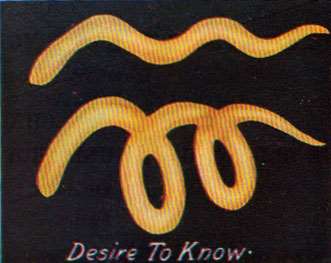 This closed the lecture, and saying that there was to be one final experiment, the professor adjusted his delicate little instrument so as to photograph instantly a variety of thought-forms that he had collected and preserved by means of rare and costly chemicals, not yet known to the Surface-World. The result, when arranged and labeled, was an interesting array. It relieved me to find that the little yellow wrigglers so plentiful in my own aura were not of a harmful or malignant character; that they meant merely the “desire to know.” I also understood the two forms most noticeable of those surrounding the students to mean “high ambitions” and “lofty intellectual aspirations.”
This closed the lecture, and saying that there was to be one final experiment, the professor adjusted his delicate little instrument so as to photograph instantly a variety of thought-forms that he had collected and preserved by means of rare and costly chemicals, not yet known to the Surface-World. The result, when arranged and labeled, was an interesting array. It relieved me to find that the little yellow wrigglers so plentiful in my own aura were not of a harmful or malignant character; that they meant merely the “desire to know.” I also understood the two forms most noticeable of those surrounding the students to mean “high ambitions” and “lofty intellectual aspirations.”
As I left the hall I reflected deeply on the lecture I had just heard. Did we, then, create for ourselves a species of guardian angels as powerful as the beings of whom we had read and known so long? Was there irreverence in the idea?
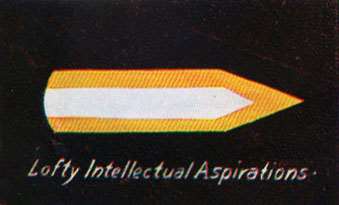 I thought it over carefully, and came to the conclusion that truth is never irreverent, if we look at it in the right way. Christ prayed that we might become one with Him, even as He was one with the Father. Then the chain would be complete, and science harmonizes with religion here as everywhere. God is the Creator. If He chooses to create through human thought, what right have we to deny Him that power? Rather let us honor and praise Him the more, and thus in the very praising, render His work through us the more beautiful.
I thought it over carefully, and came to the conclusion that truth is never irreverent, if we look at it in the right way. Christ prayed that we might become one with Him, even as He was one with the Father. Then the chain would be complete, and science harmonizes with religion here as everywhere. God is the Creator. If He chooses to create through human thought, what right have we to deny Him that power? Rather let us honor and praise Him the more, and thus in the very praising, render His work through us the more beautiful.
Since it may be true that our very thoughts take actual form, impressing their message on other lives and reacting on our own, what a mistake it would be ever to send out any but pure, true and kind ones!
Echoing through the White Telephone as I left the Under-World were the words, “As a man thinketh in his heart, so is he.”
I had always believed this; but now I understood it—and believed it the more.




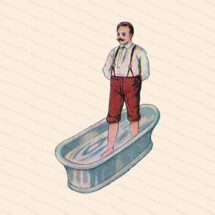
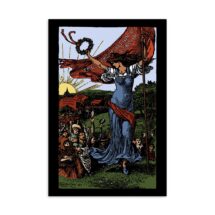




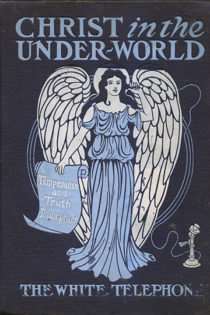
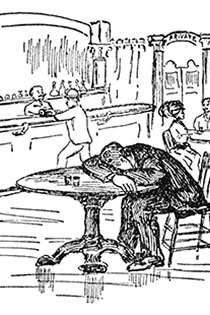

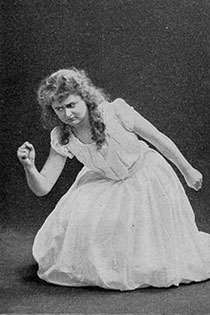









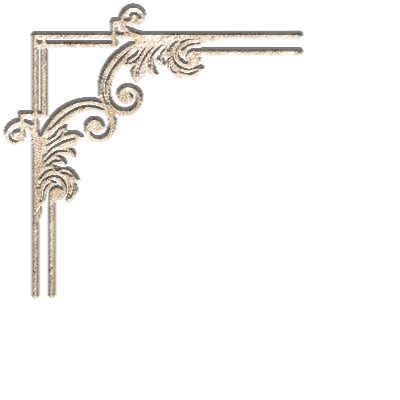

You must be logged in to post a comment.